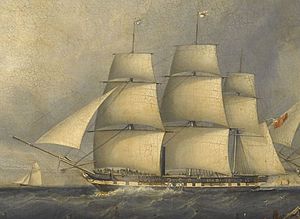Vernon (1839) facts for kids
class="infobox " style="float: right; clear: right; width: 315px; border-spacing: 2px; text-align: left; font-size: 90%;"
| colspan="2" style="text-align: center; font-size: 90%; line-height: 1.5em;" | 
|}
Vernon was a large ship built in 1839. She started her life as a paddle steamer, which means she used big wheels on her sides to move through the water. She was built in London, England, for a company called Green Blackwall Line.
Contents
| History | |
|---|---|
| Name | Vernon |
| Owner |
|
| Builder | Greens' Blackwall Yard, London |
| Completed | 1839 |
| Fate | Burnt out |
| General characteristics | |
| Tonnage | 911 GRT |
Vernon's Early Life as a Steamer
Vernon was first designed to carry passengers across the seas. She weighed 911 tons, which is like weighing 911 small cars! However, her engines used too much fuel and were not cost-effective. Because of this, her large paddle wheels were removed. She was then changed into a sailing ship, relying on wind power instead. For many years, she carried passengers to the colonies in the 1800s.
A New Purpose: Training Young Sailors
In 1867, Vernon was sold to the Colony of New South Wales. She was given a new and important job: to be a reformatory and training ship for boys. This meant she helped young boys who had gotten into trouble or needed a good start in life. On board, they learned important skills and discipline.
Where Vernon Was Moored
Vernon was anchored in Sydney Harbour. At first, she was located between the Government Domain and Garden Island. Later, in 1871, she was moved and moored off Cockatoo Island.
The End of Vernon's Service
Vernon's time as a training ship came to an end in 1892. Another ship, the Sobraon, took her place. Vernon was then sold for a small amount of money, £180, to two men named Rae and Surge. They planned to take the ship apart.
While Vernon was being broken up in Kerosene Bay on May 29, 1893, something unexpected happened. She caught fire! The fire was so strong that it burned the ship right down to the waterline, leaving almost nothing behind.

